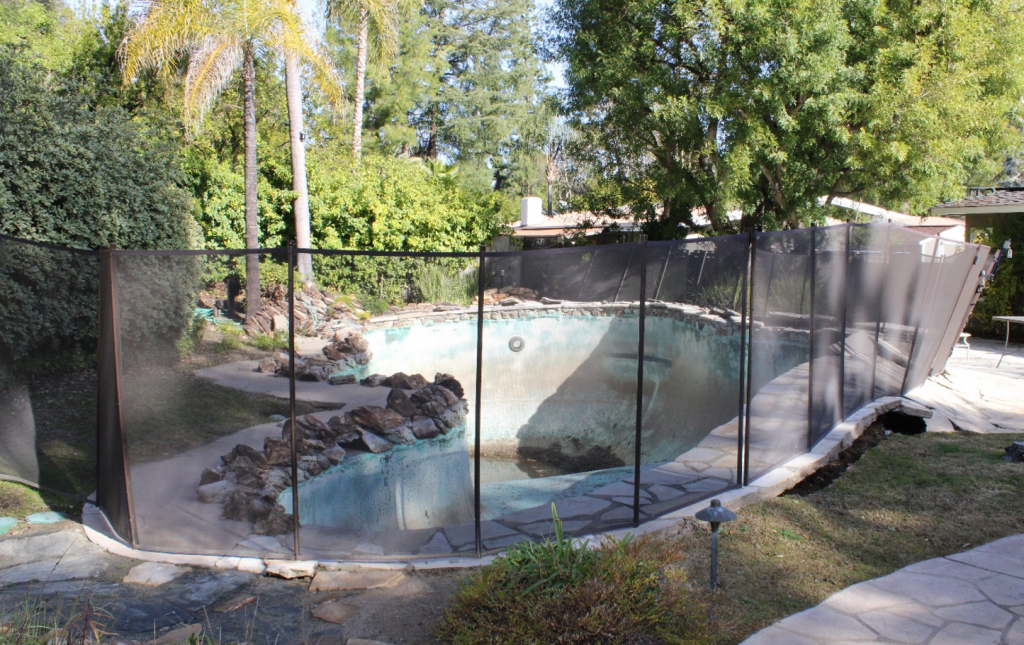Pool Concerns: After the Fire


It’s an ironic and unsettling sight: a swimming pool full of water on a property where the house has burned down. What to do with the water in fire’s immediate aftermath is a question that confronts both homeowners and their pool professionals.
By Scott Cohen
The recent wildfires in California, particularly in Pacific Palisades, Malibu, Topanga and Altadena, have caused catastrophic damage, destroyed thousands of homes and left property owners grappling with the daunting task of rebuilding.
Amidst the devastation, swimming pools that remain intact after the fires pose unique challenges that require immediate attention to ensure safety, structural integrity, and compliance with local codes. Here’s a quick look at what homeowners and pool professionals should keep in mind as they confront the damage.
IN RUINS
In addition to the emotional and financial devastation, there are immediate pool-related practical concerns left in the smoldering aftermath, starting with the water. Many homeowners have lost their pool equipment, lack access to utilities, and can no longer filter the water. This stagnant water can quickly become a breeding ground for mosquito infestations, runaway algae, and create serious drowning hazards.
Even if the home has burned to the ground, swimming pools with more than 18 inches of standing water must comply with safety enclosure codes. This is a critical point for homeowners to address, as open and accessible pools are considered an “open and obvious hazard” in legal terms and an “attractive nuisance” to young children.

Drowning accidents are a real risk, and pool owners are not exempt from pool safety regulations even after a disaster.
WHAT TO DO?
If your pool area is no longer secured due to the loss of fencing or gates, you must act immediately to either:
- Install temporary safety fencing to restrict access.
- Drain the pool to eliminate the water hazard.
However, draining a pool is not always a straightforward solution, as it introduces its own set of risks and potential costs.
While draining a pool may seem like the easiest way to mitigate safety concerns, it can have long-term consequences. Concrete and plaster pools are designed to hold water, and when left empty for extended periods (typically more than 30 days), the following issues may arise:
- Plaster Damage: Without water, the plaster finish can dry out, shrink, and crack, necessitating a complete replastering when the pool is refilled.
- Structural Cracking: The concrete shell itself can lose moisture, shrink unevenly, and develop cracks that compromise the pool’s structural integrity.
- Heaving or “Popping Out”: In areas with clay soils, expansive soils, or high water tables, an empty pool is at risk of being pushed out of the ground due to hydrostatic pressure.
If draining is unavoidable, it’s crucial to take preventive measures:
- Moisture Conditioning: Spray the exposed pool shell with water every 2–3 days to prevent the plaster and concrete from drying out completely.
- Drill Hydrostatic Relief Holes: In areas with high water tables or expansive soils, drilling 4–8 small holes into the pool floor can relieve hydrostatic pressure and reduce (not eliminate) the risk of shell movement.
BETTER LEFT FULL?
In many cases, especially during California’s rainy season, it’s safer to leave the pool filled with water. Water provides essential weight to counteract the hydrostatic pressure from surrounding soil and helps stabilize the pool structure. If you opt to keep the pool full:
- Install temporary safety fencing to meet safety compliance.
For many fire-damaged properties, the path to rebuilding homes will take years. During this time, attached swimming pools will require replacement or remodeling, either due to structural damage or to modernize the design. Post-fire, pools often suffer from:
- Smoke and Soot Damage: Residual debris can compromise pool filtration systems and affect plaster finishes.
- Heat Exposure: Intense heat from fires can weaken pool coping, tiles and shells, especially if the structure was directly exposed to flames.
If you or your clients are impacted by the fires, it is important to address these pool-related concerns as soon as reasonably possible to prevent possible injury, and to begin rebuilding process.
Scott Cohen is a nationally respected expert witness in pool-construction defect cases. He currently serves as the chairman of the California Pool and Spa Association. Cohen is a “garden artisan” and president of Green Scene Landscaping & Pools, a watershape design and construction firm based in Chatsworth, CA. A widely published author and popular speaker, Cohen is known for his gardens that combine outdoor living with inspired artistic details.









